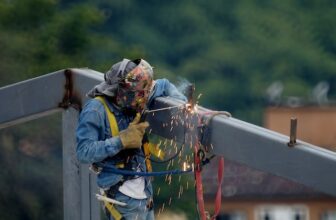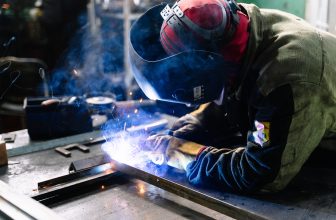You may have heard of gas metal arc GMAW welding. It’s a process that joins metals with electric current and gas through electric arc. Sometimes called metal inert gas (MIG) and metal active gas (MAG). In this article, we will cover the basics of gas metal arc welding and how to get started with the process.
There are two types of GMAW processes: solid wire electrode and flux-cored. Solid wire electrode is more versatile, but flux-cored is more common because it’s more cost-effective. We’ll focus on flux-cored gas metal arc welding in this article for easier understanding.
The process begins with selecting the proper equipment and placing the parts together in a joint configuration. Next, your welder must carefully control the amperage, voltage, and polarity to ensure that there’s enough heat for proper penetration into the joint surfaces.
What is GMAW welding?
The process is a joining method that uses electric current and a molten metal arc to heat, pierce, and melt two pieces of metal together.
The GMAW welding process, which evolved in the late 1940s when a continuously fed electrode wire replaced the tungsten electrode in GTAW, quickly became popular due to its low cost and quicker welding time. Today it is used in industries such as construction and manufacturing; car racing; vehicle production; pile driving (a type of heavy machinery); presses (a machine that compresses or squeezes material into desired shapes).
The MIG process is commonly called metal inert gas welding, or GMAW. It protects against contamination with a shielding gas- in this process, the solid wire electrode travels through the gun along with it. This type of welding can work on both thick and thin sheets of metal as well as aluminum and other nonferrous materials.
Types of Gas metal arc welders
There are four types of GMAW processes:
Short circuit
Short circuit is the coldest form of MIG welding, which uses low voltage. The welding wire touches metal and electricity goes through to create a short circuit effect. This makes for wet metal puddles that quickly solidify and fuse materials together.
Spray
This process involves melting the wire to fine droplets, which are then sprayed or misted onto weld joints. The process relies on high heat input and constant voltage. It also sends a stream of metal from arc to base material for this method.
Globular
The globular transfer method is similar to the short circuit method, but it has a higher heat input and wire that’s heated for longer periods. This creates a larger weld pool which drips into the joined area.
Pulse
While the spray arc method is similar, it has to be modified in order to address its disadvantages. Welder’s will pulse the voltage many times per second and let a droplet form at the end of their wire that gets pushed across into the puddle. The pulsed spray transfer is more functional and flexible than other methods, but can also be expensive due to requiring high-end MIG welding machines.
How to get started with GMAW welding
If you are welding, the equipment needed is dependent on what exactly you’re doing. But here’s a list of some of the essential things most people would need:
The process begins with selecting the proper equipment and placing the parts together in a joint configuration. Next, your welder must carefully control the amperage, voltage, and polarity to ensure that there’s enough heat for proper penetration into the joint surfaces.
3 recommended GMAW welders
Eastwood 180 Amp
Long ground, torch and power cables
30-180 amp welding range
Hobart Handler 210
Great performance for the price
A bit heavy at 80 lbs
Millermatic 211
Ideal for welding heavier materials
Portable
FAQs about GMAW welding
What is the process of gas metal arc welding?
The gas metal arc welding process joins metals with high-voltage electric current and an arc of molten metal. Like any welding process, it’s best for small jobs that don’t require precision.
How do I get started with GMAW?
You’ll need to purchase the equipment needed (i.e., welder, gas), but other than that, there isn’t much else to getting started. You’ll first select the proper equipment and then place your parts together in a joint configuration. If you want to learn more about how to use the equipment, make sure to ask your local store!
What Is the Difference Between GMAW and SMAW?
Shielded metal arc welding is a gas shielded process that uses a flux-covered electrode. GMAW is not, relying on an external shield for protection instead. Shielded metal arc welders also need to replace electrodes periodically, while GMAW wire electrodes are automatically fed by the machine they’re attached too.









